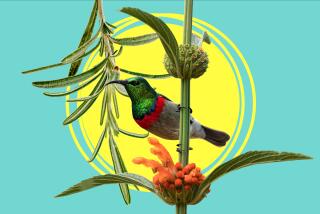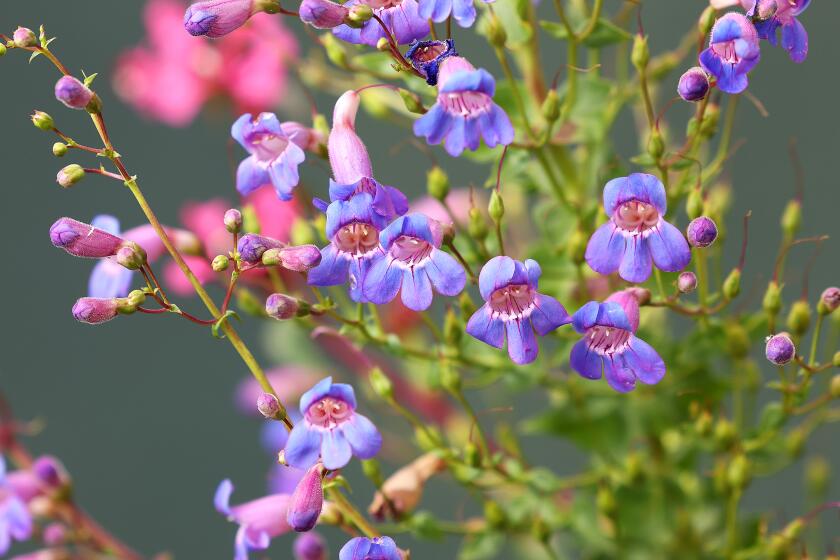Basil: Good Choice for Novice Gardener
- Share via
Some rhyme it with dazzle , others use a long a , but deciding how to pronounce the word basil and choosing which of the many varieties to plant are likely to be the only difficulties you’ll have growing and using this herb. Because basil is easy to cultivate, it’s a good choice for even novice gardeners, and the pesto and other culinary rewards far exceed the minimal effort.
This is the ideal time to plant basil, either from seeds or small plants available at most nurseries.
Because seeds can take up to two weeks to germinate, Robert Rosebrock, instructor of the UCLA Extension class “The Art of Culinary Gardening” and an admitted basil fanatic, recommends buying some plants at the nursery to plant immediately, then starting others from seeds to plant later and prolong the harvest season.
Basil grows equally well in the ground or large containers. The plants do best in full sun or semi-shade and warm, moderately rich soil (pH range of 6.4 to 7.0). They need regular watering (early in the day), especially if grown in containers. “How often you feed will depend on the richness of the soil,” says Rosebrock, but he recommends once or twice a week for plants grown in containers and after heavy harvesting.
Grow Into Bushes
You may find a tomato cage helpful in keeping the plants erect as they grow into bushes 2 to 3 feet in height, with about the same circumference. As the plants age, the stems become more woody and turn from green to brown. About the only disease that may affect basil is a blackening of the stems, which seems to occur when the plants are grown in containers without adequate drainage, and unfortunately, usually kills the plant.
Another enemy of basil is chilly, damp weather. Plants will survive well until late fall, but then must be brought inside or covered with large plastic bags each night if you want them to last into winter.
Pinching off the flowers allows the plants to grow bushy and full, prolongs the productive season and also preserves flavor in the leaves, because it naturally flows to the flowers. You’ll be able to begin harvesting leaves when the plants are about six weeks old. Harvest early in the day, before the sun lessens the oil content of the leaves. Rather than cutting whole clusters, Rosebrock advises, “pinch off just the larger leaves and allow the smaller ones to continue to grow.”
There are more than 60 varieties of basil. Of the culinary types, these are the most popular:
Sweet Basil--the most common variety, Ocimum basilicum. The plants have 1- to 2-inch toothed leaves that are a favorite for making pesto and other Italian dishes, as well as a flavorful addition to salads.
Lettuce Leaf--the large, crinkled leaves of this variety have a less intense flavor than sweet basil but are still very aromatic. Their size makes them ideal as wrappers, that may be used much the same as lettuce or grape leaves.
Crinkly Leaf--this is a cross between the sweet and lettuce varieties, with flavor less intense than sweet but more so than lettuce leaf.
Purple or Dark Opal--the name comes from the purple-bronze-colored leaves that have a spicier flavor than other basils. This variety is used in Thai cuisine, may be added to salads for color contrast or used to make herb vinegar and jelly.
Piccolo Verde Fino--the small green leaves have a very sweet flavor. This is the variety Italian chefs prefer for making pesto sauce.
Bush--because it grows in a small, tight bush, this variety is excellent for growing indoors. The leaves are small and round, with a less intense flavor than other basils.
Lemon--the small, pointed, light green leaves have a citrus aroma and flavor. Use them for making tea or to season vegetables, rice, fish or poultry. They also may be added to salads and salad dressings.
Cinnamon--the spicy aroma and flavor of the small green leaves is recommended for making jelly and chutney. Or add the leaves to fruit salad, sweet and sour dishes and rib or chicken marinades.
Anise or Licorice--the fringed green leaves have a mild, sweet flavor, not as strong as the black candy. They are a popular ingredient in Thai and Cambodian cuisine and also enhance Italian tomato-based dishes and fish.
Sacred--this variety has rough, downy-textured leaves with the scent of cloves and a pungent flavor. Use them fresh in curries or with strong flavored oily fish such as mackerel or herring.






